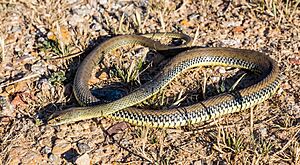Montpellier snake facts for kids
Quick facts for kids Montpellier snake |
|
|---|---|
 |
|
| Conservation status | |
| Scientific classification | |
| Genus: |
Malpolon
|
| Species: |
monspessulanus
|
| Synonyms | |
|
|
The Montpellier snake (scientific name: Malpolon monspessulanus) is a type of snake that has fangs at the back of its mouth. It produces a mild venom.
Contents
Where the Montpellier Snake Lives
This snake is very common in countries like Spain and Portugal. You can also find it in Northwest Africa. It lives along the southern coast of France and in the western parts of the Middle East. The snake's name, monspessulanus, comes from Montpellier, a city in southern France.
What the Montpellier Snake Looks Like
The Montpellier snake can grow quite long. It can reach up to 8 feet (2.55 meters) in length. It can also weigh up to 4.4 pounds (2 kilograms).
How the Montpellier Snake Behaves and What It Eats
This snake is active during the day. It mostly hunts and eats lizards.
Is the Montpellier Snake Dangerous?
Even though the Montpellier snake has venom, it is not considered dangerous to humans. There have been very few cases where people were bitten and affected. One such case happened when someone put a finger into the snake's mouth.
The fangs of this snake are located at the back of its mouth. This makes it harder for the snake to inject venom when it bites. Also, its venom is not very strong. If a large snake does manage to inject venom, the effects are usually mild. People who are bitten usually only need simple medical care.
Because this snake is not very threatening and people don't bother it much, it is quite common. You can find it in many places, even where humans live.
The History of the Montpellier Snake
Scientists believe this snake first appeared in North Africa, a region called the Maghreb. From there, it traveled into southwestern Europe between 83,000 and 168,000 years ago. It moved into southeastern Europe and western Asia even earlier.
The Montpellier snake is closely related to two other snakes. These are the Malpolon moilensis from North Africa and Arabia, and an ancient snake called Malpolon mlynarskii. This ancient snake lived in Spain a long time ago. All these snakes belong to the same group, called Malpolon.
Different Types of Montpellier Snakes
There are three main types, or subspecies, of the Montpellier snake. These live across the Mediterranean region. Scientists have noticed big genetic differences between the western type, M. m. monspessulanus, and the two eastern types, M. m. insignitus and M. m. fuscus. Some even suggest the eastern types should be considered a separate species. These groups likely split apart about 3.5 to 6 million years ago. A fourth type, M. m. saharatlanticus, was identified in 2006.
Western Montpellier Snake
The M. m. monspessulanus type lives in southwestern Europe. This includes Spain, Portugal, southern France, and northwestern Italy. It also lives in the western Maghreb, which means Morocco and coastal Algeria. Males of this type often have a dark "saddle" mark on their front body.
Eastern Montpellier Snake (fuscus)
The M. m. fuscus type is found in southeastern Europe and Turkey. It also lives through northern Iraq and western Iran.
Saharan Montpellier Snake
Another type, M. m. saharatlanticus, lives in a specific region. This area stretches from Bouizakarne in Morocco to Dakhla in the Western Sahara. It also extends inland to Aoulouz and Tafraoute.
How Humans and Montpellier Snakes Interact
Humans do not threaten the Montpellier snake. Its population is stable, and in some places, it is even growing. This is why it is listed as "Least Concern" for conservation. However, these snakes are sometimes hit by cars or killed by farmers. They are also sometimes used by snake charmers or sold as interesting items. The snake can be found in many protected areas.


